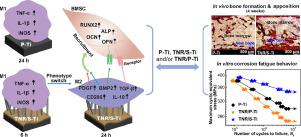Acta Biomaterialia ( IF 9.7 ) Pub Date : 2020-09-10 , DOI: 10.1016/j.actbio.2020.09.005 Hongwei Yang 1 , Meng Yu 2 , Rong Wang 1 , Bo Li 2 , Xin Zhao 1 , Yulin Hao 3 , Zheng Guo 4 , Yong Han 1

|
Current bioactive modifications of Ti-based materials for promoting osteogenesis often decrease corrosion fatigue strength (σcf) of the resultant implants, thereby shortening their service lifespan. To solve this issue and accelerate the osteogenesis process, in the present study, a TiO2 nanorods (TNR)-arrayed coating was hydrothermally grown on optimal surface mechanical attrition treated (SMATed) titanium (S-Ti). The microstructure, bond integrity, residual stress distribution, and corrosion fatigue of TNR-coated S-Ti (TNR/S-Ti) and the response of macrophages and bone marrow-derived mesenchymal stem cells (BMSCs) to TNR/S-Ti were investigated and compared with those of mechanically polished Ti (P-Ti), S-Ti, and TNR-coated P-Ti (TNR/P-Ti). S-Ti showed a nanograined layer and an underlying grain-deformed region with residual compressive stress, which was sustained even when it was hydrothermally coated with TNR. TNR on S-Ti showed nanotopography, composition, and bond strength almost identical to those of P-Ti. While TNR/P-Ti showed a considerable decrease in σcf compared to P-Ti, TNR/S-Ti exhibited an improved σcf which was even higher than that of P-Ti. Biologically, TNR/S-Ti enhanced adhesion, differentiation, and mineralization of BMSCs, and it also promoted adhesion and M1-to-M2 transition of macrophages as compared to S-Ti and P-Ti. With rapid phenotype switch of macrophages, the level of proinflammatory cytokines decreased, while anti-inflammatory cytokines were upregulated. In co-culture conditions, the migration, differentiation, and mineralization of BMSCs were enhanced by increased level of secretion factors of macrophages on TNR/S-Ti. The modified structure accelerated bone apposition in rabbit femur and is expected to induce a favorable immune microenvironment to facilitate osseointegration earlier; it can also simultaneously improve corrosion fatigue resistance of Ti-based implants and thereby enhance their service life.
中文翻译:

在表面机械磨损处理过的Ti上水热生长的TiO2-纳米棒:改善了腐蚀疲劳和成骨作用。
用于促进骨生成往往降低腐蚀疲劳强度Ti系材料的电流的生物活性的修饰(σ CF)所得的植入物,从而缩短其寿命的服务。为了解决这个问题并加速成骨过程,在本研究中,TiO 2纳米棒(TNR)排列的涂层在最佳表面机械磨损处理(SMATed)钛(S-Ti)上水热生长。TNR涂层的S-Ti(TNR / S-Ti)的微观结构,键完整性,残余应力分布和腐蚀疲劳以及巨噬细胞和骨髓间充质干细胞(BMSC)对TNR / S-Ti的反应我们研究并与机械抛光的Ti(P-Ti),S-Ti和TNR涂层的P-Ti(TNR / P-Ti)进行了比较。S-Ti表现出纳米晶粒层和下面的残余残余应力的晶粒变形区域,即使在对其进行水热涂覆TNR的情况下也能保持这种应力。S-Ti上的TNR显示出的纳米形貌,组成和结合强度几乎与P-Ti相同。虽然TNR / P-Ti系表现出相当大的降低σ CF相比P-的Ti,TNR / S-Ti系表现出的改进的σ CF甚至比P-Ti高。从生物学上讲,与S-Ti和P-Ti相比,TNR / S-Ti增强了BMSCs的粘附,分化和矿化作用,并且还促进了巨噬细胞的粘附和M1-M2过渡。随着巨噬细胞表型的快速转换,促炎细胞因子的水平下降,而抗炎细胞因子被上调。在共培养条件下,TNC / S-Ti上巨噬细胞分泌因子水平的增加增强了BMSCs的迁移,分化和矿化作用。修饰的结构加速了兔股骨的骨并置,并有望诱导良好的免疫微环境,以促进骨整合。它还可以同时提高Ti基植入物的耐腐蚀疲劳性,从而延长其使用寿命。



























 京公网安备 11010802027423号
京公网安备 11010802027423号